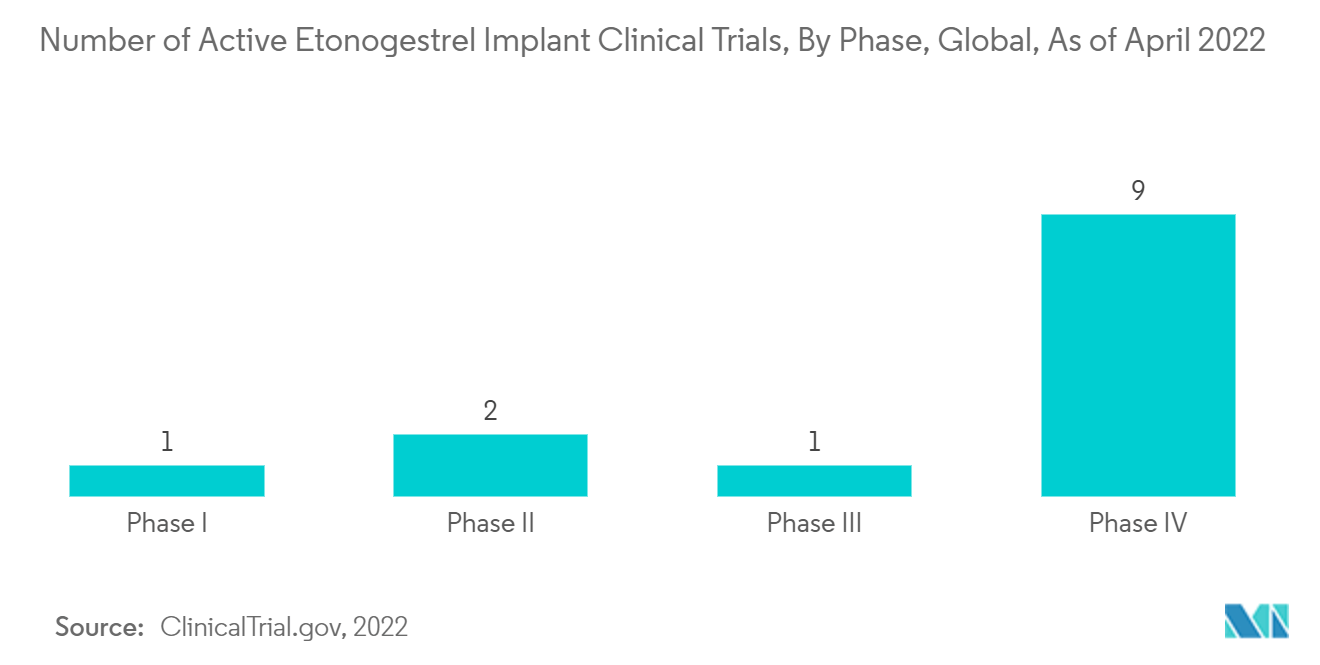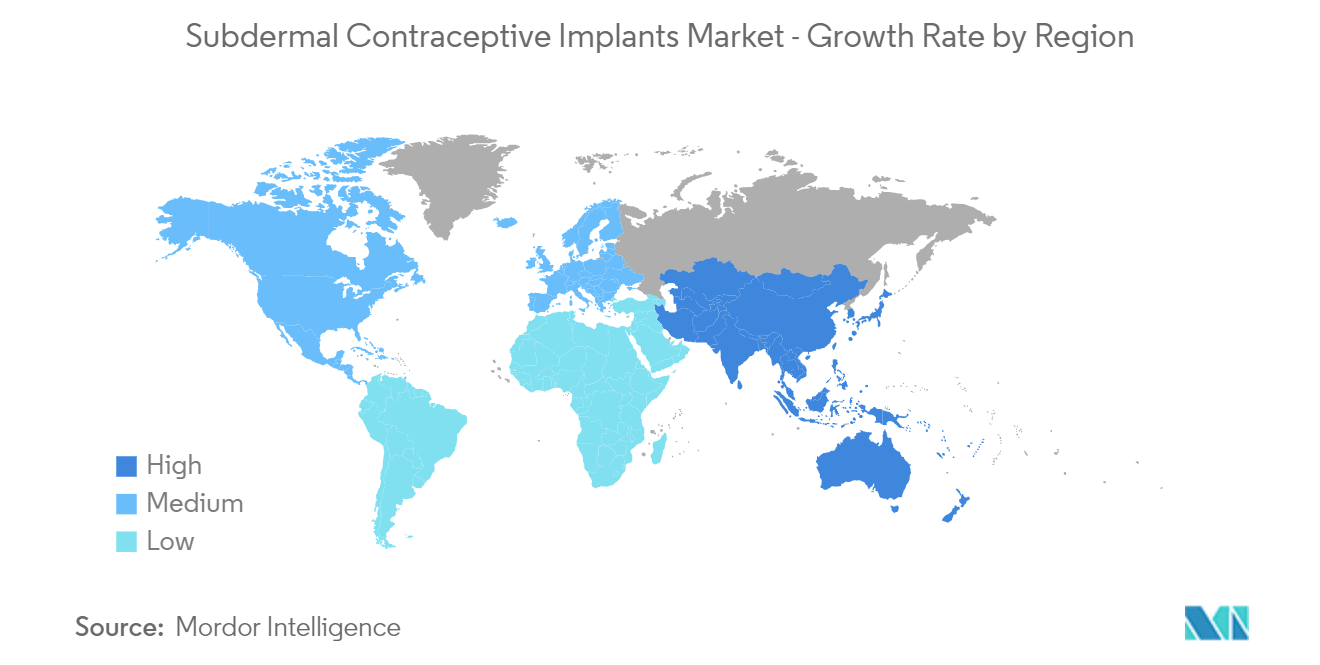Subdermal Contraceptive Implants Market Size

| Study Period | 2019 - 2029 |
| Market Size (2024) | USD 0.92 Billion |
| Market Size (2029) | USD 1.12 Billion |
| CAGR (2024 - 2029) | 3.97 % |
| Fastest Growing Market | Asia Pacific |
| Largest Market | North America |
| Market Concentration | High |
Major Players
*Disclaimer: Major Players sorted in no particular order |
Subdermal Contraceptive Implants Market Analysis
The Subdermal Contraceptive Implants Market size is estimated at USD 0.92 billion in 2024, and is expected to reach USD 1.12 billion by 2029, growing at a CAGR of 3.97% during the forecast period (2024-2029).
- The COVID-19 pandemic impacted the growth of the studied market. Initially, the global COVID-19 outbreak and the lockdown scenario in various countries had imposed some challenges on the market, as hospitals and clinics were forced to suspend services to prevent the spread of the SARS-CoV-2 virus. For instance, according to the United Nations Population Fund, in March 2021, the COVID-19 pandemic disrupted the family planning services of more than 12.0 million women, resulting in 1.4 million unplanned pregnancies. In addition, during the initial lockdown, women were nine times more likely to have difficulty accessing contraception, resulting in an almost doubling of unexpected births, from 1.3% pre-lockdown to 2.1% post-lockdown.
- Furthermore, according to the research study conducted by the United Nations Sexual and Reproductive Health Agency (UNFPA) in 2021, more than 47.0 million women lost access to contraception, leading to 7.0 million unintended pregnancies as a result of the COVID-19 crisis. Thus, during the initial phase of the pandemic, due to lower access to contraceptives, the market witnessed a negative impact. However, with the ease of restrictions, lockdown upliftments, and decreasing cases of COVID-19, the market started to gain momentum and is expected to continue the upward trend over the forecast period.
- The increasing number of unwanted pregnancies and, thereby, the rising number of initiatives to promote the use of contraceptive methods are the major drivers for the market. The number of unwanted pregnancies is increasing globally, and it is a matter of serious concern all around the world. For instance, according to the United Nations Population Fund, in March 2022, unintended pregnancies accounted for about half of all pregnancies worldwide, with 121.0 million occurring each year. The same source also stated that 60.0% of unplanned pregnancies end in abortion, with an estimated 45.0% of all abortions being unsafe, resulting in 5-13% of all maternal fatalities, putting the world's capacity to meet the Sustainable Development Goals at risk.
- Similarly, according to an article published by the NCBI in June 2021, it has been observed that unplanned pregnancy is one of Ethiopia's biggest reproductive health issues, with all of its negative consequences. Every year, on average, 4.93 million pregnancies occur, with 1.9 million Ethiopian women (38%) having an unintended pregnancy, of which 620,296 induced abortions were performed, and 103,648 women were treated for abortion-related complications. Hence, with the increasing rate of unintended pregnancies, there will be a rapid increase in the demand for contraceptive devices, which will ultimately drive market growth over the forecast period.
- Furthermore, there are countries and their respective governments that have identified the need to curb the growth of unwanted pregnancies and have started a great number of initiatives to educate and prevent the spread of unwanted abortions and pregnancies. The usage of contraceptive pills is one of them. The right to obtain and use contraceptives is part of the fundamental right to privacy guaranteed by the United States Constitution. For instance, the United States Agency for International Development (USAID) promotes and supports voluntary family planning and reproductive health initiatives in approximately 40 countries throughout the world. Thus, government initiatives are also promoting the use of contraceptive methods to avoid unnecessary births and abortions.
- Similarly, the private sector is also taking initiatives to increase the use of contraceptives. For instance, in September 2022, Unwanted 21, the regular oral contraceptive brand from Mankind Pharma, launched a multilingual campaign on the occasion of World Contraception Day in India. The campaign was aimed at creating awareness about contraceptive options along with family planning. Therefore, such favorable government and private initiatives are anticipated to propel the market growth over the forecast period.
- However, the rising prevalence of infertility, lack of awareness, and adverse effects of contraceptive implants are likely to restrain the market growth.
Subdermal Contraceptive Implants Market Trends
Etonogestrel Implant Segment is Expected to Witness Considerable Growth Over the Forecast Period
- The etonogestrel implant segment is expected to witness significant growth over a forecast period owing to factors such as high clinical effectiveness and high adoption rate. Etonogestrel is a hormone that prevents ovulation. This medication also causes changes in the cervical mucus and uterine lining, making it harder for sperm to reach the uterus and harder for a fertilized egg to attach to the uterus.
- Subdermal etonogestrel implant is used as contraception to prevent pregnancy. The medicine is contained in a small plastic rod that is implanted under the skin of the upper arm. The medicine is released slowly into the body. The rod can remain in place and provide continuous contraception for up to 3 years.
- The increasing company focus on adopting various business strategies such as product launches, listing products in the countries, mergers, and company spin-offs are likely to boost the growth of the market over the forecast period. For instance, in June 2021, Merck spun off Organon to make it an independent Women's Health company. The company will operate in women's healthcare with a portfolio of contraceptive and fertility brands, dermatology, respiratory, and bone health products. In addition, in January 2022, Organon announced the public listings for NEXPLANON (etonogestrel extended-release subdermal implant) in Ontario (Ontario Drug Benefit Program), British Columbia (BC PharmaCare), and Nova Scotia (Nova Scotia PharmaCare).
- Similarly, in November 2021, Organon announced the public listings for NEXPLANON (etonogestrel extended-release subdermal implant) in Quebec under the Régie de l'assurance Maladie du Québec (RAMQ). Thus, the increasing approvals and product launches are likely to increase the demand for etonogestrel implants. Therefore, considerable segment growth is anticipated over the forecast period.

North America is Expected to Maintain Dominance during the Forecast Period
- North America is expected to witness considerable growth over the forecast period. The growth is due to factors such as rising cases of unwanted pregnancies and high abortion rates, technological advancements, as well as supportive government schemes. For instance, according to the Guttmacher Institute, in March 2022, there were more than 5,660,000 pregnancies annually between 2020 and 2022, of which 2,590,000 were unwanted, and 886,000 resulted in abortion in North America.
- Furthermore, as per the same source, in Canada, there were more than 570,000 pregnancies annually between 2020 and 2022, of which 265,000 were unwanted, and 97,500 resulted in abortion. Thus, the increasing cases of unwanted pregnancies and abortion rates are likely to increase the demand for subdermal contraceptive implants, thereby increasing market growth in the North American region.
- Key product launches, high concentration of market players or manufacturers' presence, acquisition and & partnerships among major players, and rising initiatives towards contraceptive technologies in the United States are some of the factors driving the growth of the subdermal contraceptive implants market in the country.
- For instance, as per the Bill & Melinda Gates Foundation data published in 2022, the foundation is aiming to offer USD 280.0 million per year from 2021 to 2030 for developing new and improved contraceptive technologies, support family planning programs that reflect the preferences of local communities, and enable women and girls to be in control of their contraceptive care. Thus, the rising incidences of unwanted pregnancies and abortion rates and the aforementioned developments are anticipated to boost the adoption of subdermal contraceptive implants in the country, thereby boosting market growth over the forecast period.

Subdermal Contraceptive Implants Industry Overview
The global subdermal contraceptive implants market is competitive and consolidated and consists of very few major players. Some of the key companies are Organon, Shanghai Dahua Pharmaceutical Co., Ltd., and Bayer AG, which hold a substantial market share in the market.
Subdermal Contraceptive Implants Market Leaders
-
Shanghai Dahua Pharmaceutical Co., Ltd.
-
Bayer AG
-
Organon
*Disclaimer: Major Players sorted in no particular order

Subdermal Contraceptive Implants Market News
- February 2023: The Family Planning Association of India (FPAI) has been promoting the use of a new contraceptive, Implanon NXT. The subdermal single-rod implant (Implanon NXT) is a new reversible contraceptive with a long-term effect. It replaces older types of contraceptive implants such as Norplant, Jadelle, Sino-implant, and Implanon.
- April 2022: ProMed Pharma began preclinical evaluation of a novel, fully resorbable contraceptive implant after getting the funds from the Bill & Melinda Gates Foundation.
Subdermal Contraceptive Implants Market Report - Table of Contents
1. INTRODUCTION
1.1 Study Assumptions and Market Defination
1.2 Scope of the Study
2. RESEARCH METHODOLOGY
3. EXECUTIVE SUMMARY
4. MARKET DYNAMICS
4.1 Market Overview
4.2 Market Drivers
4.2.1 Rise in the Number of Initiatives to Promote Contraceptive Methods
4.2.2 Increasing Number of Unwanted Pregnancies
4.3 Market Restraints
4.3.1 Rising Prevalence of Infertility
4.3.2 Lack of Awareness and Adverse Effects of Contraceptive Implants
4.4 Porter's Five Forces Analysis
4.4.1 Threat of New Entrants
4.4.2 Bargaining Power of Buyers/Consumers
4.4.3 Bargaining Power of Suppliers
4.4.4 Threat of Substitute Products
4.4.5 Intensity of Competitive Rivalry
5. MARKET SEGMENTATION (Market Size by Value - USD)
5.1 By Type
5.1.1 Etonogestrel Implant
5.1.2 Levonorgestrel Implant
5.2 Geography
5.2.1 North America
5.2.1.1 United States
5.2.1.2 Canada
5.2.1.3 Mexico
5.2.2 Europe
5.2.2.1 Germany
5.2.2.2 United Kingdom
5.2.2.3 France
5.2.2.4 Italy
5.2.2.5 Spain
5.2.2.6 Rest of Europe
5.2.3 Asia Pacific
5.2.3.1 China
5.2.3.2 India
5.2.3.3 Australia
5.2.3.4 South Korea
5.2.3.5 Rest of Asia-Pacific
5.2.4 Rest of the World
6. COMPETITIVE LANDSCAPE
6.1 Company Profiles
6.1.1 Organon
6.1.2 Shanghai Dahua Pharmaceutical Co., Ltd.
6.1.3 Bayer AG
- *List Not Exhaustive
7. MARKET OPPORTUNITIES AND FUTURE TRENDS
Subdermal Contraceptive Implants Industry Segmentation
Subdermal contraceptive implants refer to those implants which involve the delivery of a steroid progestin from polymer capsules or rods placed under the skin. The hormone diffuses out slowly at a stable rate, providing contraceptive effectiveness for 1-5 years.
The subdermal contraceptive implants market is segmented by type (etonogestrel implant and levonorgestrel implant) and geography (North America, Europe, Asia-Pacific, and Rest of the World). The market report also covers the estimated market sizes and trends for 16 different countries across major regions globally.
The report offers the value (in USD) for the above segments.
| By Type | |
| Etonogestrel Implant | |
| Levonorgestrel Implant |
| Geography | ||||||||
| ||||||||
| ||||||||
| ||||||||
| Rest of the World |
Subdermal Contraceptive Implants Market Research FAQs
How big is the Subdermal Contraceptive Implants Market?
The Subdermal Contraceptive Implants Market size is expected to reach USD 0.92 billion in 2024 and grow at a CAGR of 3.97% to reach USD 1.12 billion by 2029.
What is the current Subdermal Contraceptive Implants Market size?
In 2024, the Subdermal Contraceptive Implants Market size is expected to reach USD 0.92 billion.
Who are the key players in Subdermal Contraceptive Implants Market?
Shanghai Dahua Pharmaceutical Co., Ltd., Bayer AG and Organon are the major companies operating in the Subdermal Contraceptive Implants Market.
Which is the fastest growing region in Subdermal Contraceptive Implants Market?
Asia Pacific is estimated to grow at the highest CAGR over the forecast period (2024-2029).
Which region has the biggest share in Subdermal Contraceptive Implants Market?
In 2024, the North America accounts for the largest market share in Subdermal Contraceptive Implants Market.
What years does this Subdermal Contraceptive Implants Market cover, and what was the market size in 2023?
In 2023, the Subdermal Contraceptive Implants Market size was estimated at USD 0.88 billion. The report covers the Subdermal Contraceptive Implants Market historical market size for years: 2019, 2020, 2021, 2022 and 2023. The report also forecasts the Subdermal Contraceptive Implants Market size for years: 2024, 2025, 2026, 2027, 2028 and 2029.
Subdermal Contraceptive Implants Industry Report
Statistics for the 2024 Subdermal Contraceptive Implants market share, size and revenue growth rate, created by Mordor Intelligence™ Industry Reports. Subdermal Contraceptive Implants analysis includes a market forecast outlook to 2029 and historical overview. Get a sample of this industry analysis as a free report PDF download.



